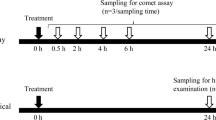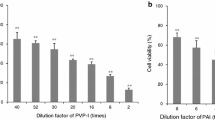Abstract
Rabbit eyes were contaminated with 1-chloroacetophenone (CN) and dibenz(b.f)-1∶4-oxazepine (CR) in solution (1 to 10% in polyethylene glycol 300), as a solid (0.1 to 5 mg), and as aerosols (15 min exposure to 360 to 719 mg/m3). In solution, CN caused marked and persistent inflammatory effects, the severity and duration being related to the concentration used. Corneal damage was marked and persistent with 5 and 10% solutions; the lowest concentration causing just detectable keratitis in a small proportion of animals was 2%. Solid CN was even more damaging to the eye than similar amounts in solution. In marked contrast, CR in solution caused mild to moderate inflammatory effects, usually of only a few days duration, even at the higher concentrations. With 1 and 2 %, these effects were just detectable to mild, lasting for 24 hrs or less. 10% CR caused just detectable keratitis of usually only a few days duration; the lowest concentration causing just detectable keratitis in a small proportion of treated animals was 5%. Solid CR merely caused minor irritation of the conjunctivae and eyelids for about 1 hr. Aerosols of CN and CR did not damage the eye, but irritation of the lids and conjunctivae was more marked and persistent with CN. Solutions of CN and CR caused concentration-related increases in corneal thickness and intraocular tension, being more marked and sustained with CN.
Zusammenfassung
Kaninchenaugen warden der Einwirkung folgender Reizstoffe ausgesetzt: 1-Chloroacetophenon (CN) und Dibenz(b.f)-1∶4-oxazepin (CR) als 1%- und 10%-Lösung in Polyäthylenglykol 300; in fester Form (0,1 bis 5 mg) und als Schwebstoff, Einwirkungszeit 15 min, Konzentration 360 bis 719 mg/m3. Als Lösung verursachte CN deutliche und langdauernde Entzündungserscheinungen, deren Schwere und Dauer von der verwendeten Konzentration abhängig war. CN als 5- und 10% Lösung verursachte eine bedeutende und lange andauernde Schädigung der Hornhaut; 2% war die niedrigste Konzentration von CN, welche eine gerade merkbare Keratitis in einigen Tieren der Gruppe erzeugte. Ganz anders waren die Verhältnisse im Falie von CR. In Lösung verursachte CR nur milde bis mäßige Entzündungserscheinungen, welche sogar bei höherer Konzentration nur ein paar Tage dauerten. CR in 1 bis 2% Lösung hatte gerade noch merkbare Wirkung, welche nur 24 Std oder sogar kürzer anhielt. CR als 10% Lösung verursachte eine ganz milde Keratitis, welche gewöhnlich nur einige Tage dauerte. Die niedrigste Konzentration, welche eine vorübergehende, gerade noch merkbare Keratitis in einem kleinen Anteil der behandelten Tiere hervorrief, war 5%. CR in fester Form verursachte nur eine geringfügige Reizung der Bindehaut und Augenlider, welche nach ungefähr 1 Std abklang. CN und CR als Schwebstoff rief keine Augenschädigung hervor, aber die Reizung der Augenlider und Bindehaut durch CN war stärker und von längerer Dauer. Sowohl CN als auch CR, als Lösung, verursachte konzentrationsabhängige Hornhautverdickungen und einen Anstieg des Augendruckes. Im Falle von CN ist die Wirkung viel stärker und von längerer Dauer.
Similar content being viewed by others
References
Ballantyne, B.: The acute toxicology of dibenz(b.f)-1∶4-oxazepine. (In preparation 1975)
Ballantyne, B., Gall, D., Robson, D. C.: Effects on man of drenching with dilute solutions of o-chlorobenzylidene malononitrile (CS) and dibenzoxazepine (CE). (In preparation 1975)
Ballantyne, B., Gazzard, M. F., Swanston, D. W.: Effects of solvents and irritants on intraocular tension in the rabbit. J. Physiol. (Lond.) 226, 12–14 (1972)
Ballantyne, B., Gazzard, M. F., Swanston, D. W., Williams, P.: The ophthalmic toxicology of o-chlorobenzylidene malononitrile (CS). Arch. Toxicol. 32, 149–168 (1974)
Ballantyne, B., Price Thomas, D., Beswick, F. W.: The presentation and management of individuals contaminated with solutions of dibenzoxazepine (CR). Med. Sci. Law 13, 265–268 (1973)
Ballantyne, B., Swanston, D. W.: Ocular irritation tests. Brit. J. Pharmcol. 46, 577–578 (1972)
Ballantyne, B., Swanston, D. W.: The irritant effects of dilute solutions of dibenzoxazepine (CR) on the eye and tongue. Acta pharmacol. (Kbh.) 35, 412–423 (1974)
Ballantyne, B., Swanston, D. W.: The scope and limitations of acute eye irritation tests. In: Current approaches to toxicology (ed. B. Ballantyne). Bristol: Wright & Sons (in press)
Burton, A. B. G.: A method for the objective assessment of eye irritation. Food cosmet. Toxicol. 10, 209–217 (1972)
Callaway, S., Gazzard, M. F., Price Thomas, D., Swanston, D. W.: The calibration and evaluation of a hand-held tonometer as a means of measuring the intraocular pressure in the conscious rabbit. Exp. Eye Res. 15, 383–393 (1973)
Dixon, M.: Reactions of lachrymators with enzymes and proteins. Biochem. J. 42, 26–28 (1948)
Drury, R. A. B., Wallington, E.: Carleton's histological technique, p. 359. Oxford: University Press 1967
Easty, D. L., Mathalone, M. B. R.: Toxicity of 1,8,9-triacetoxyanthracene to the cornea in rabbits. Brit. J. Ophthal. 53, 819–823 (1969)
Gaskins, J. R., Hehir, R. M., McCaulley, D. F., Ligon, E. W.: Lacrimating agents (CS and CN) in rats and rabbits. Arch. environ. Hlth 24, 449–454 (1972)
Grant, W. M.: Chemical burns of the eye. J. Amer. med. Ass. 142, 152–159 (1950)
Grant, W. M.: Toxicology of the eye, p. 123. Springfield: C. Thomas 1962
Hoffmann, D. H.: Eye burns caused by tear gas. Brit. J. Ophthal. 51, 265–268 (1967)
Laibson, P. R., Oconor, J.: Explosive tear gas injuries of the eye. Trans. Amer. Acad. Ophthal. Otolaryng. 74, 811–819 (1970)
Levine, R. A., Stahl, C. J.: Eye injury caused by tear-gas weapons. Amer. J. Ophthal. 65, 497–508 (1968)
Lillie, R. D.: Histopathologic technic and practical histochemistry, p. 38. New York: McGraw Hill 1965
Mackworth, J. F.: The inhibition of thiol enzymes by lachrymators. Biochem. J. 42, 82–90 (1948)
MacLeod, I. F.: Chemical mace: Ocular effects in rabbits and monkeys. J. forens. Sci. 14, 34–47 (1969)
Macrae, W. G., Willinsky, M. D., Basu, P. K.: Corneal injury caused by aerosol irritant projectors. Canad. J. Ophthal. 5, 3–11 (1970)
Maurice, D. M., Giardini, A. A.: A simple optical apparatus for measuring the corneal thickness, and the average thickness of the human cornea. Brit. J. Ophthal. 35, 169–177 (1951)
Midtbo, A.: Eye injury from tear gas. Acta Ophthal. (Kbh.) 42, 672–679 (1964)
Oaks, L. W., Dorman, J. E., Petty, R. W.: Tear gas burns of the eye. Arch. Ophthal. 63, 698–706 (1960)
Pearse, A. G. E.: Histochemistry, theoretical and applied, p. 831. London: Churchill 1960
Punte, C. L., Guttentag, P. J., Owens, E. J., Gongiver, L. E.: Inhalation studies with chloroacetophenone, diphenylaminochloroarsine, and pelargonic morpholide. 11. Human exposures. Amer. industr. Hyg. Ass. J. 23, 199–202 (1962)
Rengstorff, R. H.: Tear gas and riot control agents: a review of eye effects. Optometric Weekly 60, 25–28 (1969)
Rose, L.: Mace, a dangerous police weapon. Ophthalmologica (Basel), Additamentum ad vol. 158, 448–454 (1968)
Stahl, C. J., Young, B. C., Brown, R. J., Ainsworth, C. A.: Forensic aspects of tear-gas pen guns. J. forens. Sci. 13, 442–469 (1968)
Thomas, C. I.: The Cornea, p. 866. Springfield: C. Thomas 1955
Walter, F.: The microtome. p. 25. Wetzlar: Scharfer KG 1961
Ytteborg, J., Dohlman, C.: Corneal oedema and intra-ocular pressure. 1. Animal experiments. Arch. Ophthal. 74, 375–381 (1965)
Author information
Authors and Affiliations
Rights and permissions
About this article
Cite this article
Ballantyne, B., Gazzard, M.F., Swanston, D.W. et al. The comparative ophthalmic toxicology of 1-chloroaceto-phenone (CN) and dibenz(b.f)-1:4-oxazepine (CR). Arch. Toxicol. 34, 183–201 (1975). https://doi.org/10.1007/BF00353282
Received:
Issue Date:
DOI: https://doi.org/10.1007/BF00353282




